1911
Olle Bærtling was born on December 6, 1911, in Halmstad. During his school years, Bærtling showed an interest in technology and drawing.
1928
In 1928, Bærtling moved to Stockholm and underwent commercial training.
1929
The following year, he got a job as a banker at the Skandinaviska Kreditaktiebolaget i Stockholm in Stockholm (which changed its name to Skandinaviska Banken in 1939).

Olle Bærtling in his office at Skandinaviska Banken, Stockholm, 1945. Photographer unknown, Bærtling Foundation archive.
1934-35
From 1934-35, Bærtling began painting in his spare time and developed an increasing interest in art, attending croquis drawing classes at Otto Sköld’s painting school in Stockholm. He also attended lectures by curator Ragnar Hoppe at the National Museum and followed the art scene in Stockholm.
1938-39
During 1938-39, Bærtling painted in a Nordic expressionistic style, strongly influenced by French art and the artist Henri Matisse. He married Lisa von Roxendorff in 1939.
1940-42
From 1940-42, he was inspired by the paintings of Vincent van Gogh and Carl Kylberg and moved to Kommendörsgatan 39 in Stockholm.
1945-48
Between 1945-48, abstract forms in painting became more apparent with strong black contours, inspired by Georges Rouault, defining the elements of the motif. In 1947, Bærtling traveled to London, where he developed contour painting, depicting the bombed city. This trip made him realize how he could benefit from the graphic patterns of contour painting in his expressive painting.

Olle Bærtling paints in London, 1947. Photo: Lisa von Roxendorff-Bærtling © Bærtling Foundation.
In 1948, Bærtling traveled to Paris where he studied for a time with the cubist André Lothe. Disliking strong contour lines, Lothe’s approach led Bærtling to Fernand Léger, who appreciated his work. Bærtling’s visual world changed, and his relationship to color and form became different, with colors losing their naturalistic character and forms becoming less connected to the outside world.

Olle Bærtling studies Ksar, 1948 in his studio apartment at Kommendörsgatan 39 in Stockholm, 1949. Photo: Harry Berger.
1949
In 1949, Bærtling transitioned from an expressionist-cubist technique to full color planes and emphasized lines, marking his debut exhibition at the Art Gallery Collector in Stockholm. By the turn of the year 1949-50, Bærtling completely abandoned the figurative tradition, starting to explore visual illusions – the afterimages that occur when observing forms and colors.
1950-51
In the spring of 1950, Bærtling spent time in Paris painting large powerful canvases mostly in black, red, and white, working with straight lines and full color planes.
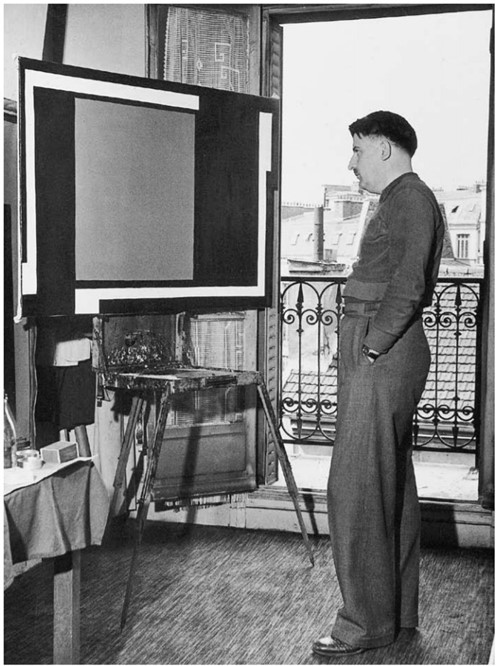
Olle Bærtling studies Hommage au Luxembourg, 1950 at Hôtel des Ecoles on rue Delambre, Paris 1950. Photo: Lennart Olson © Hallands Konstmuseum.
He met the artist Auguste Herbin in Paris, who introduced Bærtling to the Salon des Réalités Nouvelles, a French art salon founded in 1946 primarily for abstract art. Bærtling gained attention in the Paris art scene and began experimenting with diagonals and sharp angles.
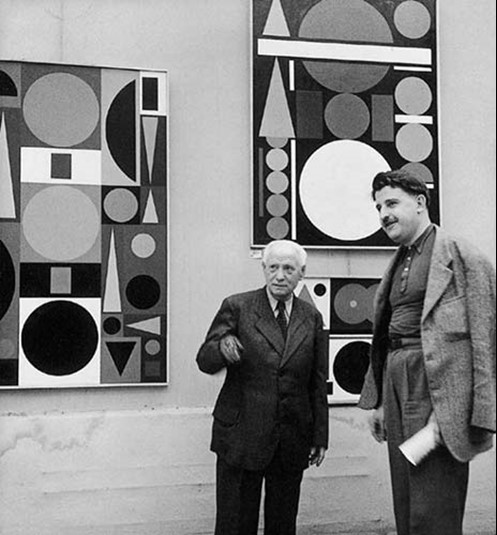
Auguste Herbin and Olle Bærtling at the Salon des Réalités Nouvelles, Paris 1950. Photo: Lennart Olson © Hallands Konstmuseum.
Bærtling exhibits together with Auguste Herbin at Galleri Brinken in Stockholm, 1951.
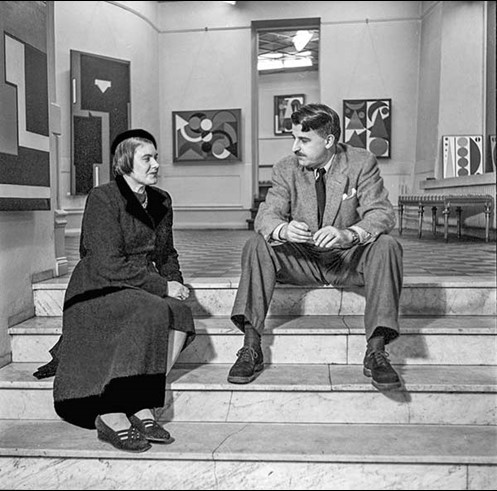
Lisa von Roxendorff-Bærtling and Olle Bærtling at the exhibition “Herbin-Bærtling”,
Galleri Brinken, Stockholm 1951. Photo: Lennart Olson © Hallands Konstmuseum
Bærtling medverkar i utställningen “Neoplasticism” på Konstsalongen Samlaren i
Stockholm 1951.
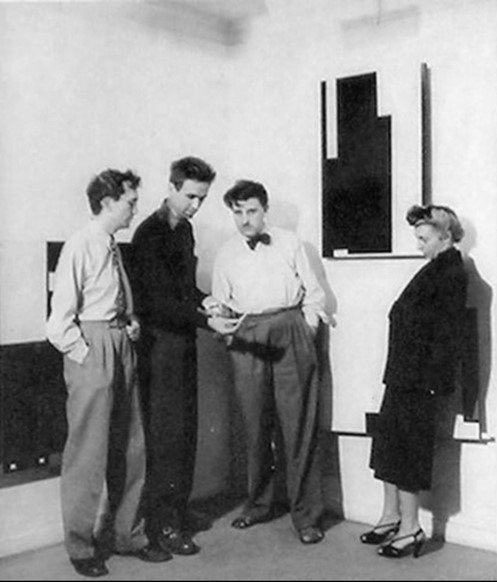
Oscar Reutersvärd, Carlo Derkert, Olle Bærtling, and Agnes Widlund at the exhibition “Neoplasticism,” Konstsalongen Samlaren, Stockholm 1951. Photo: Lennart Olson © Hallands Konstmuseum
1952
Bærtling further develops the diagonal dynamics, which gradually transition into a play with open pointed triangles. He becomes increasingly interested in the integration of art and architecture, which he considers to be the art monuments of the future.
He participates in the founding of Groupe Espace in Paris and joins the international group of artists around Galerie Denise René in Paris.
1953
Bærtling experiments with making the colors in different color fields appear to move at different speeds.
He participates in the exhibition “L’art suédois 1913-1953” at Galerie Denise René, Paris, and Galerie Apollo, Brussels. It is the first comprehensive exhibition of Swedish cubism and concretism organized outside of Sweden.
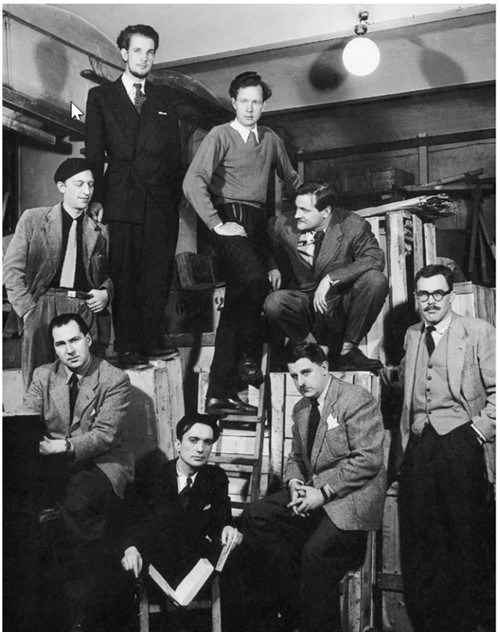
Preparations for the exhibition “L’art suédois 1913-1953,” in the basement of the Royal Academy of Fine Arts, Stockholm, 1953. From left: Arne Jones, Karl-Axel Pehrson, Olle Bonniér, Oscar Reutersvärd, Lennart Rhode, Lars Rolf, Olle Bærtling, Pontus Hultén. Photo: Lennart Olson © Hallands Konstmuseum
1954
From 1954 onwards, Bærtling exclusively paints open acute angles – “open Bærtling triangles”. Visual space and movement are pursued.
He exhibits the installation “Fyrsidig komposition” (Four-sided composition) in front of the Konstsalongen Samlaren in Stockholm. The work is a proposal for the design of the Swedish pavilion at the Venice Biennale.
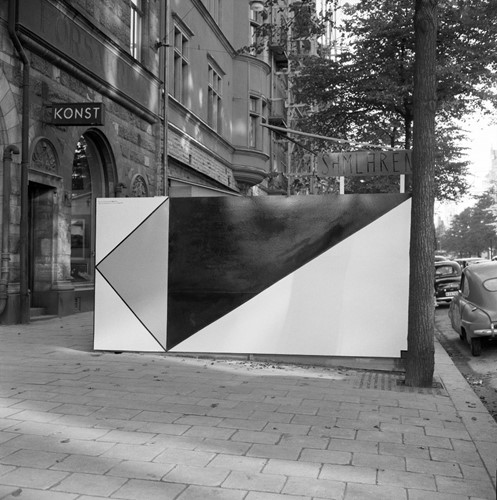
“Fyrsidig komposition” by Olle Bærtling exhibited outside Konstsalongen Samlaren, Stockholm 1954. Photo: Lennart Olson © Hallands Konstmuseum
Bærtling begins experimenting with sculptures and designs fabrics for NK’s Textilkammare (a section of the department store Nordiska Kompaniet in Stockholm).
1955
He paints large canvases this year, which he exhibits in Stockholm in 1956.
His first solo exhibition in Paris at Galerie Denise René. With the gallery’s reputation, Bærtling achieves international recognition.
1956
He participates in the exhibition “Concrete Realism” together with Robert Jacobsen and Richard Mortensen at Liljevalchs konsthall in Stockholm.
He resigns from his job at Skandinaviska Banken.
He begins working with steel tube sculptures.
1957-58
In 1957, he reduced the material body of sculptures to only visible lines. The sculptures now become immaterial sources of energy – analogous to the paintings.
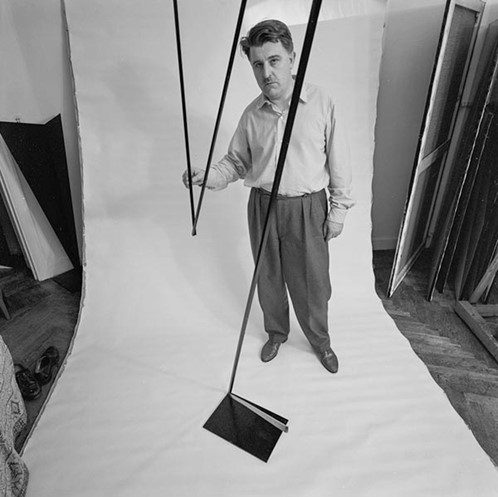
Olle Bærtling with the sculpture “Kerok,” 1957. Photo: Lennart Olson © Hallands Konstmuseum
During 1958, Bærtling works simultaneously with painting and sculpture, considering them as the same expression.
The formal language in Bærtling’s artworks is enriched. New colors are used. He experiments with a variety of different colors with similar temperatures.
1959-60
On behalf of the City of Stockholm, Bærtling executes mural paintings in the entrance hall of the first high-rise building in Stockholm’s new city during 1959-1960. With this entrance hall, Bærtling’s and architect David Helldén’s idea of “the aesthetic space” is realized – a space where architecture and art have been integrated.

Olle Bærtling’s mural composition from 1959-1960 in the entrance hall of the first Hötorgsskrapan, Sveavägen 17, Stockholm 1960. Photographer unknown. ArkDes
1961-64
Bærtling creates the sculpture Asamk in 1961, a prototype standing 7.7 meters tall intended to be 84.7 meters high and placed at Sergels torg in Stockholm. The intended sculpture would be the world’s tallest freestanding sculpture. He exhibits this prototype at the “Aspect” exhibition at Liljevalchs konsthall in Stockholm in 1961.

Olle Bærtling examines Asamk, 1961 at Liljevalchs konsthall in Stockholm ahead of the “Aspect 61” exhibition, 1961. Photo: Lennart Olson © Hallands Konstmuseum
Bærtling, together with architect David Helldén, develops a proposal for an auditorium for Stockholm’s new university. The building is called Rymdaulan, and its shape is a three-dimensional triangle placed on one of its points, a form that “opens up to space,” according to Bærtling and Helldén.

Model of Rymdaulan proposed by Olle Bærtling and David Helldén for Stockholm University. Photographer unknown, Bærtling Foundation Archive.
Bærtling participates in the 7th São Paulo Biennial in 1963 and receives an award.
The colors violet, black, and “Bærtling white” dominate the paintings. The angles in the compositions widen with the tip pointing downward.
Bærtling participates in the Guggenheim International Award 1964 organized by the Solomon R. Guggenheim Museum in New York.
First solo exhibition in the USA at Columbia University in New York in 1964.
Bærtling receives the Swedish state’s income guarantee for artists in 1964.
1965
Composer Jan W. Morthenson collaborates with Bærtling on “Compositions for Television,” where image and sound interact without illustrating each other. The program aired on Swedish television in May 1965.
Solo exhibition at Chicago University, Chicago, and at the Rose Fried Gallery, New York.
1966
Bærtling reduces the dimensions of sculptures to increase their immaterial visual power.
Solo exhibition at the University of Minnesota, Minneapolis.
1967
On behalf of Uppsala Municipality, Bærtling carries out art decoration for the new high school Celsiusskolan in Uppsala. The architect is Gösta Wikforss.
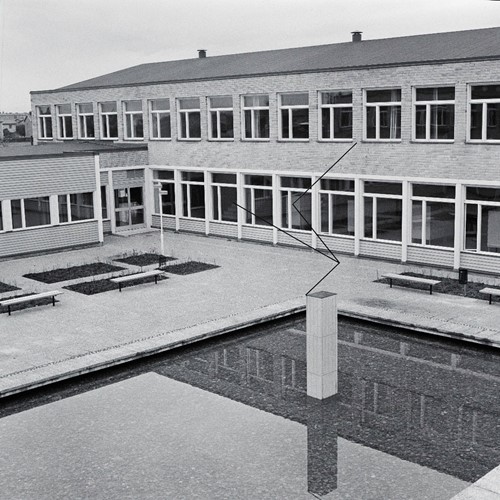
Olle Bærtling’s sculpture “Xiak,” 1966, in one of the courtyards of Celsiusskolan, Uppsala, 1967. Photographer unknown, Bærtling Foundation’s archive.
Bærtling participates in the exhibition “The 1960s: Painting and Sculpture from the Museum Collection” at the Museum of Modern Art, New York.
1968
Rose Fried Gallery in New York presents the retrospective exhibition “The Angles of Bærtling – Open From Infinite Space – from Cinétisme to Open Form 1949-1968.”
1969
Plans to erect a 60-meter-high sculpture atop the Wenner-Gren Center in Stockholm. The prototype for the monumental sculpture is the 460 cm high sculpture “Xyya” from 1967. The project was not realized.
Solo exhibition at Esther-Robles Gallery in Los Angeles.
Retrospective exhibition at the Royal Swedish Academy of Fine Arts in Stockholm.
1970
On behalf of the Swedish National Public Art Council (Statens konstråd), Bærtling carries out art embellishment at Stockholm University’s new campus in Frescati. Bærtling installs ten paintings, a sculpture, and suspended ceiling screens in seminar corridors in collaboration with architect David Helldén. The paintings were relocated to a safer location in 1983.
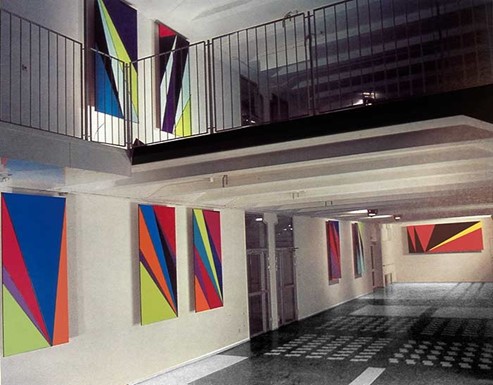
Artistic embellishment by Olle Bærtling at Stockholm University in 1970. Photo: Göran Lundström
Solo exhibition at Axiom Gallery in London.
1971-73
The paintings are dominated by violet and teal, becoming increasingly dynamically open.
The sculptures gain greater kinetic dynamism. The sharp angles create faster speed and spatial immateriality.
In 1971, Bærtling creates the sculpture Yayao, height 525 cm, intended as a prototype for the sculpture he would like to see erected in Riddarfjärden in Stockholm. In its final form, this sculpture would be 525 meters high. The project was not realized.
He experiments with compositions in other materials and produces flags.
Solo exhibition at Galleria Lorenzelli in Milan in 1973.
1974-75
He executes, commissioned by the City of Stockholm, a window curtain as textile decoration for the new Culture House in Stockholm in 1974. The architect is Peter Celsing.
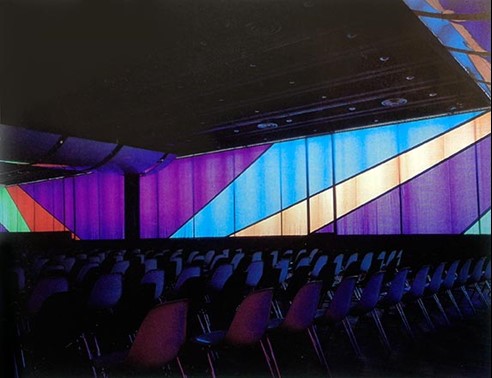
Textile decoration by Olle Bærtling in the Auditorium of the Culture House, Stockholm 1974. Photo: Göran Lundström
Solo exhibition at Galleria della Trinità in Rome 1974.
The visual energy of the violet color significantly increases in the paintings as Bærtling begins to use a new hue (quinacridone). The angle points move further and further beyond the paintings.
Solo exhibition at Junior Galerie in Zurich 1975.
1976
Bærtling has his flags hoisted at Nybroplan in Stockholm.

Bærtling creates, commissioned by the Centre National d’Art et de Culture Georges Pompidou in Paris, a prototype for a 45-meter high sculpture intended to be placed on the museum’s roof. The museum purchases the prototype Yayao, 1971 but does not complete the execution of the full-scale sculpture.
Separate exhibition organized by Kunstverein für die Rheinlande und Westfalen, Düsseldorf, at Kunsthalle Düsseldorf.
1977
Bærtling designs flag displays for Sweden’s challenger boat in the America’s Cup 1977.
Solo exhibition at Contemporary Royale, Vancouver, Canada.
1978
Moves to Norr Mälarstrand 16 in Stockholm.
Together with the German architect Gerd Fesel, Bærtling designs a 300-meter-high telecommunications tower in Abu Dhabi. It was planned to be located in the sea on an artificial island off Abu Dhabi. The inspiration for the design was the sculpture Yayao from 1971. In addition to telecommunications, the facility was intended to include a hotel with 250 rooms, a rotating restaurant spanning six floors, and official premises for the government of the United Arab Emirates.
Bærtling also collaborates with architect Gerd Fesel on designing a TV tower and parliamentary building in Düsseldorf. This project includes a 230-meter-high tower and a three-sided pyramid resting on one of its points.
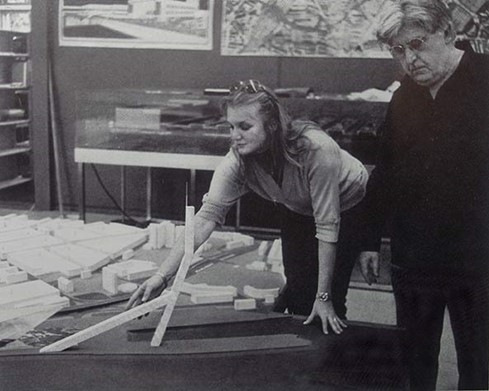
Architect Gerd Fesel and Olle Bærtling with a model of the TV tower and parliamentary building for Düsseldorf, 1978. Photographer unknown, Bærtling Foundation Archive.
1980-81
In 1980-81, Bærtling prepares a major retrospective exhibition for Malmö Konsthall. The exhibition became a memorial exhibition that was also shown at the Moderna Museet in Stockholm.
Olle Bærtling passes away on May 2, 1981, in Stockholm.

Olle Bærtling in front of Ksiru, 1976, in his studio apartment at Norr Mälarstrand 16, Stockholm, 1980. Photo: Olle Wester/Expressen